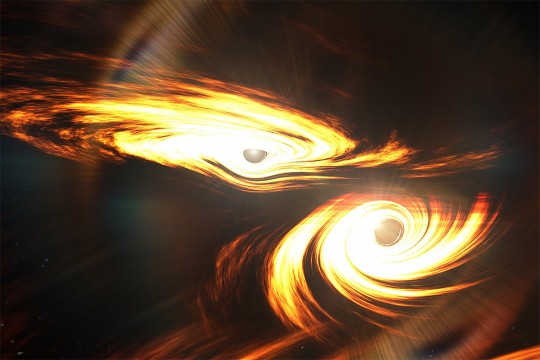News
Astrophysical Sciences and Technology Ph.D.
-
July 18, 2022
![researchers wearing head sets and eye-tracking glasses.]()
RIT will begin offering two new Ph.D. programs in fall of 2023
RIT will begin offering two new Ph.D. programs beginning in the fall of 2023: business administration and cognitive science. Today, RIT enrolls 300 students in 11 Ph.D. programs.
-
June 6, 2022
![an artist's impression of the view from a planet that may have formed in the disk of gas and dust orbiting a star.]()
RIT professor earns NASA grant to study baby stars and newborn planets closest to Earth
A team of RIT scientists is poring over NASA data for new insights about Earth’s youngest, closest neighbors. Joel Kastner, a professor in RIT’s Chester F. Carlson Center for Imaging Science and School of Physics and Astronomy, received nearly $400,000 for a NASA archival study to advance our understanding of newly formed stars and planets.
-
May 23, 2022
![portrait of student Olivia Young.]()
RIT student Olivia Young receives prestigious NSF Graduate Research Fellowship
Astrophysical sciences and technology Ph.D. student Olivia Young earned a competitive fellowship from the National Science Foundation to develop machine learning algorithms that will help scientists use radio telescopes to study transient objects such as pulsars and fast radio bursts.
-
January 31, 2022
![researcher with different samples of organic materials called biochar.]()
RIT expands Ph.D. portfolio
RIT’s strategic plan calls for adding six to 12 new Ph.D. programs and conferring 50 doctoral degrees every year by 2025. The university already reached the latter goal with 51 Ph.D. degrees conferred in the 2020-2021 academic year.
-
January 20, 2022
![Artist’s impression of binary black holes about to collide.]()
RIT scientists confirm a highly eccentric black hole merger for the first time
For the first time, scientists believe they have detected a merger of two black holes with eccentric orbits. According to a paper published in Nature Astronomy by researchers from RIT and the University of Florida, this can help explain how some of the previous black hole mergers are much heavier than previously thought possible.
-
December 16, 2021
![artists rendering of the James Webb Space Telescope.]()
Multiple RIT scientists contribute to the newest space telescope
When the James Webb Space Telescope (JWST) launches, it will mark the culmination of nearly 30 years of development on the most powerful observational instrument ever made. Numerous members of RIT’s College of Science have been involved in its creation or will work on projects once it becomes operational.
-
December 6, 2021
![the Vela pulsar, a rapidly rotating neutron star.]()
RIT scientists develop machine learning techniques to shed new light on pulsars
New machine learning techniques developed by scientists at Rochester Institute of Technology are revealing important information about how pulsars—rapidly rotating neutron stars—behave. In a new study published by Monthly Notices of the Royal Astronomical Society, the researchers outlined their new techniques and how they applied to study Vela, the brightest radio pulsar in the sky.
-
November 16, 2021
![student wearing hard hat and clean suit working on rocket equipment.]()
RIT astrophysics graduate students conduct experiment at White Sands Missile Range
Serena Tramm and Mike Ortiz are pursuing their studies in astrophysics and have been working alongside Michael Zemcov, assistant professor in RIT’s School of Physics and Astronomy. Together, the team conducted an experiment that resulted in traveling to New Mexico’s White Sands Missile Range for the first CIBER-2 launch earlier this year.
-
November 8, 2021
![chart showing 90 gravitational wave events.]()
LIGO-Virgo-KAGRA Collaboration announces 90 gravitational wave discoveries to date
The LIGO-Virgo-KAGRA Collaboration unveiled several studies that shed important new light on the nature of gravitational waves. They include a “census” of gravitational wave events to date and a new catalog of results from the second half of its third observing run.
-
October 4, 2021
![RIT astrophysical sciences and technology Ph.D. student Peter Craig.]()
Astrophysical sciences and technology Ph.D. student receives DOE award to study dark matter
RIT’s Peter Craig is one of 65 graduate students from 29 states to receive an award from the U.S. Department of Energy’s Office of Science Graduate Student Research (SCGSR) program. He will conduct research at Lawrence Berkeley National Laboratory.
-
June 29, 2021
![Graph showing electromagnetic measurements of neutron stars and black holes.]()
Scientists detect gravitational waves for the first time from black holes swallowing neutron stars
For the first time, scientists detected gravitational waves caused by mergers between black holes and neutron stars. Researchers from RIT’s Center for Computational Relativity and Gravitation (CCRG) helped identify key characteristics about the merger events.
-
June 17, 2021
![researcher making adjustments to a rocket.]()
CIBER-2 experiment successfully completes first flight
Led by principal investigator Michael Zemcov, an assistant professor in RIT’s School of Physics and Astronomy and Center for Detectors, the experiment aims to better understand extragalactic background light, which traces the history of galaxies back to the formation of the first stars in the universe.





















